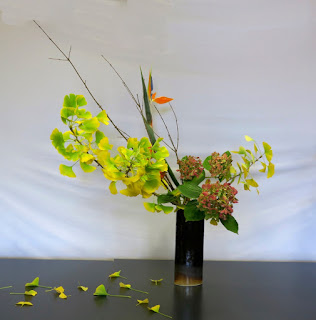 |
| My persimmon tree, which produces masses of fruit but the local fauna leave very few for us. It's worth having such a tree if only for the autumn colour. |
Autumn is a glorious time of year for us Victorians. We often envy the more northern states for their warm weather but, come autumn, we can be grateful for the chill that produces the wonderful colours on our deciduous trees.
 |
| My weeping Japanese maple |
 |
| The golden elm, which we share with our neighbours |
 |
| My favourite of all my trees, the ginkgo biloba. |
Last Friday and Saturday we, the Sogetsu group, had our annual workshops with Yoshiro Umemura. We always look forward to these workshops and have not been disappointed yet.
On Friday afternoon we were challenged by a completely new theme - 'Create an arrangement which some would surely say "You shouldn't do that"'. In other words, break some ikebana rules.
Umemura sensei created a flower-like shape out of disposable wooden forks glued together. He then placed them in a container shaped like a curved pipe and added tortured willow for line and scattered flower petals for colour. We have always been taught to avoid 'crafty' works. This was the rule sensei was breaking.
When I first read the brief for this workshop my first thought was to make an arrangement up-side-down. I have since come up with other ideas but I went with my first. It is important, when addressing a particular theme, to end up with a pleasing ikebana arrangement as well. It took me an inordinate amount of time to balance the ceramic container on the big, curly branch, which I found on the footpath. I had to remove some pieces from one side and add them to the other several times, until I reached equilibrium. I then considered the flowers, which looked wrong when placed up-side-down. I chose gerberas, not my favourite flowers, because I could wire them and curve them so that they faced upwards when placed in the vase. Of course, I had their stems in little water vials.
When I took the arrangement home, I turned it right-side-up and straightened the stems of the geberas to, again, face upwards. If I had kept it up-side-down it would have disturbed my family, in particular my son-in-law, Warren, who can't tolerate a picture on the wall being even slightly crooked.
 |
| A more conventional arrangement |
 |
Our second workshop was of an autumn arrangement in a nageire vase using a vertical fixture. Sensei used stachyurus, beauty berries and roses.
I used ginkgo, hydrangeas, three pomegranates (not visible in photo) and a strelitzia.
Nicole used liquidambar and hydrangeas.
Lucy used viburnum opulus stems and rhododendron.
For our third workshop, we swapped containers and then swapped materials, so that we, each, had to make a completely improvised arrangement. I did not get to photograph mine, but Lucy photographed hers, so I leave you with that.
Please go to Sogetsu Ikebana Melbourne for photographs of arrangements by the other members.
Bye for now,
Emily









No comments:
Post a Comment